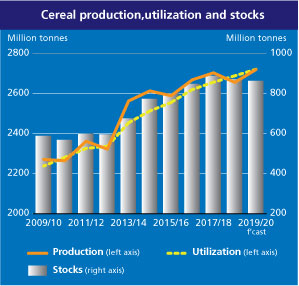IntroductionSecure Your Food has been monitoring resources and outlooks that track vulnerabilities and threats to the food system - as early as February 25, we were urging people on our social media to prepare responsibly for possible disruptions and accessibility to food should the COVID-19 virus spread to Canada. On March 17, Premier Kenney declared a provincial Public Health Emergency and enacted measures designed to slow the spread of the virus. Presently there is enough food within the food chain supply that any short-term effects from the virus on our food system will not be noticed. However, with the spread of COVID-19, we are observing vulnerabilities of our food system becoming magnified. The effects of the COVID-19 continue to wreak havoc on elements within the food chain and this has the effect of rising prices and shortages regionally. This effect is magnified in urban and virus affected areas which may have the potential to lead to social strife. Looking at areas like China, Italy, and Spain, we have witnessed rioting, hoarding, and starvation because workers in all levels of production, manufacture, distribution, and transport get sick and this results in the inability to operate normally. Food Chain under stressWith no clear end in sight, the food system is adapting to pandemic conditions. To add context, in previous blog postings we have documented the difficulties our food system has due to extreme weather and Climate Change. World wide food production in the last couple of years has largely been dependent on weather conditions, and recent trends show a downward trend with some staple crops having the lowest yields in a century. Last year, the Food and Agriculture Organization of the United Nations reported that the world’s consumption level has outpaced production (as cited in Fraser, 2020, Building Resilience, para. 5). It is unknown specifically what may occur with COVID-19 in this mix but we are certain that it makes a serious situation worse. ProductionThe Canadian Federal Government has designated the food supply chain as critical infrastructure, and in concert the Alberta Provincial government has designated food growing activities as vital and needed. The province declared agricultural activities along with greenhouses, nurseries, and farmer markets as essential services (Bezovie, 2020, para.1). Agriculture and Agri-Food Canada has taken to relax import workers restrictions and extend present worker visas to meet the demand for workers employed in agriculture (Agriculture and Agri-Food Canada, 2020, “temporary foreign worker”, para.1). Despite efforts to contain the virus, farm workers in West Kelowna had to self isolate and the farm shut down (Pinkerton & Emmanuel, 2020, paras. 1-3). Mirroring last year's conditions, farmers in Central Alberta hoped to do early plantings but weather and COVID-19 will delay planting (Chacon, 2020, paras. 1-2). Manufacture and ProcessingFood manufacturing and processing facilities are facing significant health challenges as conditions meant to keep food safe happen to also allow the virus to remain virulent. In lab testing, cold weather conditions are “conducive” to virus survival (Lab Manager, 2020, para. 7). Also, keep in mind that cold conditions reduce mucus in the respiratory tract, which is protective from virus and cold infections (Friar, 2017, para. 4). Cargill’s meat packing plant, in High River, has laid off 1000 workers due to 38 confirmed cases of COVID-19 illnesses (Rieger, 2020, para. 3). Harmony Beef, a beef processing plant north of Calgary, has closed because of virus afflicted workers (“Confirmed case”, 2020, paras. 1-3). National corporations that process food, largely meat processing, have begun to shut down or reduce their activities as workers become sick (Financial Post, 2020, List). DistributionThe border between the U.S. and Canada remains closed to cross country travel but still allows the free flow of goods and materials (Agriculture and Agri-Food Canada, 2020, Trade, Question 2). For context, the Just in Time Delivery system employs global supply chains which supplies our marketplace with goods, especially during the off growing season. A large part of produce comes from the United States, especially California, but when supplies are low the supply chain sources food from further south, like Mexico and Central America. COVID-19 has demonstrated that there is not enough resilience within the system, as the efficiency of the supply chain does not allow alternate sources of food and researchers assert that regional sources of food need to be developed (Fraser, 2020, Building Resilience, para. 2). TransportThe COVID-19 virus has long term implications for the industry of transportation. Transport Canada has issued requirements of truck drivers that include social distancing, hand washing, and cleaning of vehicles before and after deliveries to limit the spread of the virus (TruckNews, 2020, para.1). International shipping experienced a downward trend due to the U.S./China trade war and the virus, the demand for goods is slowing and experts forecast a drawdown by June (McClearn, 2020, Shipping, para. 2-3). Many air carriers have begun to limit flights with travel restrictions in place, resulting in less cargo that travels alongside passengers (McClearn, 2020, Air Cargo, para. 1). With plane transport slowing down, train deliveries are set to increase given its ability to move large volumes of goods and foods (McClearn, 2020, para. 3). Railway companies are observing transportation for car and petroleum products decreasing, but materials and goods for food infrastructure are being maintained (McClearn, 2020, Railways, paras. 2-3). ConclusionThis summary is not exhaustive but a sampling of what is being observed regionally and internationally. Before COVID-19, the food chain was experiencing difficulties due to extreme weather and climate change. The virus has negatively affected all levels of our food system and the system is adapting within the constraints of its ability, however that may not be enough during this difficult time. There are limited redundancies within the system and because of this, vulnerabilities become magnified. The areas where we source our food are out of the country and have health systems not on par with our level. Most countries in the northern and southern hemisphere have not reached their peak with the virus, and as the virus proceeds to spread, it is likely that food prices will continue to increase and shortages become much more likely. Gardening is one way you can secure a source of food and the time to start is now. Nurseries and greenhouses will have seedlings which you can transplant for the growing season. Secure Your Food will continue to provide resources on our social media and blog postings on how to grow your own food. It is prudent that you grow your own food especially with what we are observing in the world. ReferencesAgriculture and Agri-Food Canada (2020). Coronavirus disease (COVID-19) - Information for the agriculture and agri-food industry. Retrieved from https://www.agr.gc.ca/eng/coronavirus-disease-covid-19-information-for-the-agriculture-and-agri-food-industry/?id=1584732749543 Bezovie, E. (2020, April 15). Greenhouses, nurseries and farmers' markets declared essential during COVID-19. Canadian Television Network. Retrieved from https://www.edmonton.ctvnews.ca/greenhouses-nurseries-and-farmers-markets-declared-essential-during-covid-19-1.4897698 Confirmed case of COVID-19 shuts down beef plant north of Calgary. (2020, March 27). Canadian Broadcasting Corporation. Retrieved from https://www.cbc.ca/news/canada/calgary/covid-19-harmony-beef-deena-hinshaw-alberta-1.5513408 Financial Post (2020, April 13). Coronavirus closes meat plants in Canada and the United States as world's largest pork producer warns of shortages. Retrieved from https://www.financialpost.com/news/retail-marketing/coronavirus-spread-closes-north-american-meat-plants Friar, G. (2017, March 17). Mucus Does More Than You Think. Scope. Retrieved from https://www.scopeweb.mit.edu/mucus-does-more-than-you-think-8b12f8f6feae Fraser, E. (2020, March 16). COVID-19: The perils of a 'just enough, just in time' food system. Arrell Food Institute. Retrieved from https://arrellfoodinstitute.ca/covid-19-food-system/ Lab Manager (2020, March 12). Researchers Predict Potential Spread and Seasonality for COVID-19 Based on Climate Where Virus Appears to Thrive. Retrieved from https://www.labmanager.com/news/researchers-predict-potential-spread-and-seasonality-for-covid-19-based-on-climate-where-virus-appears-to-thrive-21994 McClearn, M. (2020, April 19). Upheaval in supply and demand for goods throws transportation networks into disarray. Globe and Mail. Retrieved from https://www.theglobeandmail.com/canada/article-planes-trains-and-ships-sit-idle-as-transport-networks-grind-to-a/ Pinkerton, C. & Emmanuel, R. (2020, April 1). The Sprout: COVID-19 outbreak among foreign workers at West Kelowna farm. IPolitics. Retrieved from https://www.ipolitics.ca/2020/04/01/the-sprout-covid-19-outbreak-among-foreign-workers-at-west-kelowna-farm/ Rieger, S. (2020, April 14). The company says shifts have been reduced but hasn't confirmed the number of layoffs. Canadian Broadcasting Corporation. Retrieved from https://www.cbc.ca/news/canada/calgary/cargill-layoffs-1.5532568 Transport Canada releases Covid-19 guidelines for fleets and drivers. (2020, April 2). TruckNews. Retrieved from https://www.trucknews.com/transportation/transport-canada-releases-covid-19-guidelines-for-fleets-and-drivers/1003139012/
0 Comments
Leave a Reply. |
AuthorWrite something about yourself. No need to be fancy, just an overview. Archives
March 2022
Categories |


 RSS Feed
RSS Feed